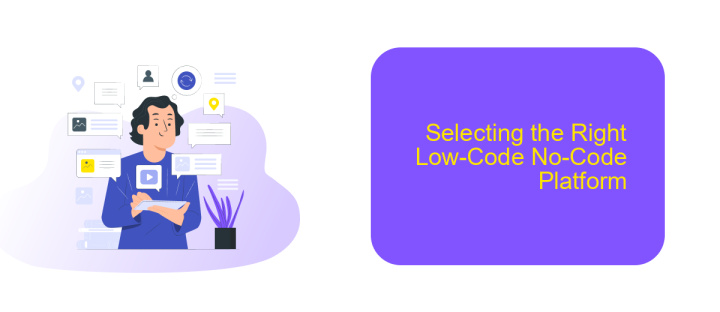Low-Code No-Code Use Cases
Low-code and no-code platforms are revolutionizing the way businesses approach software development. By enabling users to create applications with minimal coding knowledge, these tools empower a broader range of individuals to solve complex problems and innovate rapidly. This article explores various use cases where low-code and no-code solutions have made significant impacts across different industries.
Introduction to Low-Code No-Code
Low-Code and No-Code platforms are revolutionizing the way businesses develop applications, offering a faster and more accessible alternative to traditional coding. These platforms enable users with little to no programming experience to create, modify, and deploy applications through user-friendly interfaces and drag-and-drop functionalities.
- Speed: Rapid development and deployment of applications.
- Cost-Effective: Reduces the need for specialized developers.
- Accessibility: Empowers non-technical staff to build applications.
- Flexibility: Easily adaptable to changing business requirements.
One of the key advantages of Low-Code and No-Code platforms is their ability to integrate with other services seamlessly. Tools like ApiX-Drive simplify this process by allowing users to connect various applications and automate workflows without writing a single line of code. This enhances productivity and ensures that different systems within an organization can communicate effectively.
Use Cases in Various Industries

Low-code and no-code platforms are revolutionizing various industries by enabling faster and more efficient application development. In the healthcare sector, these platforms facilitate the creation of patient management systems, telehealth applications, and data analytics tools without the need for extensive coding knowledge. This empowers healthcare professionals to improve patient care and streamline administrative tasks. Similarly, in the financial industry, low-code and no-code solutions are used to develop custom financial applications, automate workflows, and enhance compliance processes, thereby increasing operational efficiency and reducing costs.
In the realm of e-commerce, businesses leverage low-code and no-code platforms to build personalized shopping experiences, manage inventory, and optimize customer relationship management. For instance, ApiX-Drive offers a seamless way to integrate various e-commerce platforms and automate data flow between them, enhancing overall operational efficiency. In the education sector, these platforms enable the rapid development of e-learning applications, student information systems, and virtual classrooms, making education more accessible and interactive. Overall, low-code and no-code solutions are transforming industries by democratizing application development and fostering innovation.
Benefits and Limitations

Low-Code and No-Code platforms offer numerous benefits, making them increasingly popular for various use cases. These platforms significantly reduce development time, allowing businesses to quickly deploy applications. They also lower costs by minimizing the need for specialized developers. Moreover, they enable non-technical users to create and modify applications, fostering greater innovation and flexibility within organizations.
- Rapid development and deployment
- Cost-effective solutions
- Empowerment of non-technical users
- Enhanced flexibility and innovation
However, these platforms come with limitations. Customization options may be limited, restricting the ability to create highly specialized applications. Scalability can also be an issue, as these platforms may not handle complex, large-scale projects efficiently. Additionally, integrating with other systems can sometimes be challenging. Services like ApiX-Drive can help mitigate this by providing seamless integration capabilities, ensuring that Low-Code and No-Code solutions can work harmoniously with existing systems.
Selecting the Right Low-Code No-Code Platform

Choosing the right Low-Code No-Code platform is crucial for the success of your projects. Start by identifying your specific needs, such as the complexity of the applications you plan to build and the level of customization required. Evaluate the platform's ease of use, scalability, and ability to integrate with existing systems.
Consider the following factors when making your decision:
- Usability: Ensure the platform is user-friendly and accessible to both technical and non-technical users.
- Scalability: The platform should support growth and handle increased workloads efficiently.
- Integration Capabilities: Look for platforms that offer robust integration options with other tools and services, such as ApiX-Drive for seamless data flow.
- Customization: Assess the extent to which the platform allows for customization to meet your unique business requirements.
- Support and Community: A strong support system and active user community can be invaluable for troubleshooting and learning.
By carefully evaluating these factors, you can select a Low-Code No-Code platform that not only meets your current needs but also supports your future growth and innovation. This strategic choice will empower your team to develop and deploy applications more efficiently.


Future Trends and Considerations
As we look to the future, the adoption of low-code and no-code platforms is expected to accelerate, driven by the increasing demand for rapid application development and the democratization of technology. These platforms will continue to evolve, offering more sophisticated tools and capabilities that allow even non-technical users to create complex applications. Integration with other technologies, such as artificial intelligence and machine learning, will further enhance the functionality and potential use cases of low-code and no-code solutions.
One significant trend is the growing importance of seamless integrations with existing systems and third-party services. Tools like ApiX-Drive are becoming essential, as they enable users to easily connect various applications and automate workflows without requiring extensive coding knowledge. This trend towards enhanced interoperability will empower organizations to streamline operations and improve efficiency. Additionally, security and governance will remain critical considerations, ensuring that as these platforms become more widespread, they also adhere to stringent standards and best practices to protect sensitive data and maintain regulatory compliance.
FAQ
What is Low-Code/No-Code development?
Who can benefit from Low-Code/No-Code platforms?
What are some common use cases for Low-Code/No-Code platforms?
How do Low-Code/No-Code platforms handle integrations with other software?
Are Low-Code/No-Code platforms secure?
Time is the most valuable resource for business today. Almost half of it is wasted on routine tasks. Your employees are constantly forced to perform monotonous tasks that are difficult to classify as important and specialized. You can leave everything as it is by hiring additional employees, or you can automate most of the business processes using the ApiX-Drive online connector to get rid of unnecessary time and money expenses once and for all. The choice is yours!

